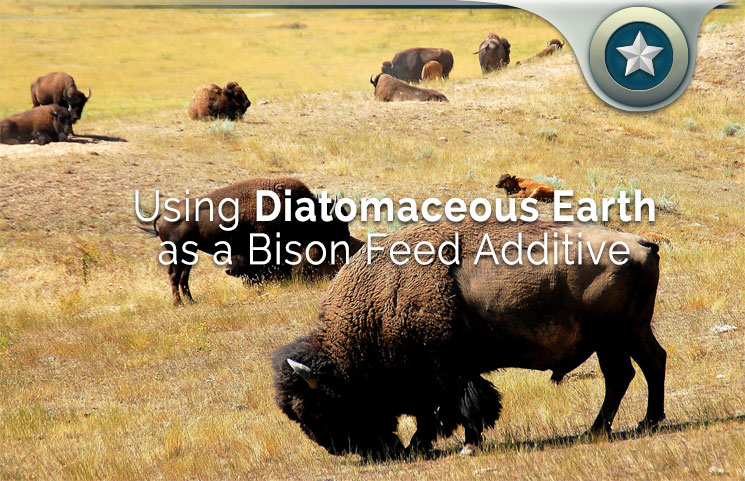There are many factors that can render bison feed unusable. If stored incorrectly, bison feed can become excessively damp, causing fungus, mold, mildew and rot. Insect pests also like to infest the dry food used as bison feed, and are difficult to prevent.
Many of the most commonly used preservative agents designed to protect bison feed from either rot or insects contain potentially harmful chemicals that can negatively impact the health of your livestock.
Diatomaceous earth, or DE, has a number of properties that make it a highly effective natural bison feed additive. DE is mined from mineral deposits formed from the remains of ancient lake beds, streams, and rivers.
These deposits contain the fossilized remains of ancient aquatic plant life called diatoms. Over millions of years, these deposits are converted through mineralization into a powdery substance that is composed of over 85% silica.
The silica content of diatomaceous earth is highly absorbent and abrasive. These properties are what makes diatomaceous earth such an effective feed additive.
When added to bison feed, diatomaceous earth will absorb any excess moisture content, preventing the formation of rot, fungus or mold.
DE also acts as a powerful chemical-free insecticide. When insect feed pests encounter diatomaceous earth, the fine silica particles bind to their exoskeleton and wear away their protective outer coating, absorbing the moisture from inside their bodies and fatally dehydrating them.
The fine powdery nature of diatomaceous earth also makes it a powerful anti-caking agent, and the trace mineral content of the substance offers a significant boost in critical mineral nutrients for your livestock.
In this article, we’ll provide a simple step-by-step process that details the best method of adding diatomaceous earth to your bison feed.
What You’ll Need
- Food Grade Diatomaceous Earth
- Food Scales
- A Diatomaceous Earth Applicator
- Airtight Feed Container
Step 1: Choose The Right Diatomaceous Earth Grade
The most important step in adding diatomaceous earth to your bison feed is making sure you’ve chosen the right grade of DE.
There are several grades of diatomaceous earth, of which some can be extremely hazardous to both human and animal health. Pest control grade diatomaceous earth, for example, is often mixed with toxic insecticides to increase its efficacy.
Pool grade diatomaceous earth is composed of tiny silica crystals that are formed when raw DE is exposed to extremely high temperatures. These silica crystals are extremely efficient pool filters but are incredibly hazardous to both your health and that of your livestock.
Whenever using diatomaceous earth in any application that involves ingestion by either humans or animals, always ensure you’re using food grade diatomaceous earth that has been approved as GRAS, or generally regarded as safe, by the FDA.
This is the only form of natural, organic, chemical-free diatomaceous earth.
Step 2: Weight Your Bison Feed
In order to determine the correct amount of diatomaceous earth to add to your bison feed, you’ll first need to weight the feed you’re planning on mixing. Either mark down the total weight of the feed bag you’ll be mixing, or weight the feed with food scales.
Step 3: Measure The Correct Amount Of Diatomaceous Earth
After weighing your feed, you’ll need to weigh out the correct amount of diatomaceous earth. The best ratio for diatomaceous earth to feed is 2% of the total feed weight.
To work this out, take the total feed weight and divide it by 50, then measure this amount of diatomaceous earth.
Step 4: Mix Diatomaceous Earth And Bison Feed
Mix the feed and DE by transferring both into a separate, airtight container. Begin by lightly dusting the inside of a dry container with DE, then apply alternating layers of bison feed and diatomaceous earth.
Each layer of bison feed should be 3-4 inches thick, with a fine layer of diatomaceous earth on top. Using a diatomaceous earth applicator will streamline this process and reduce mess.
The best applicator for mixing bison feed is the Wilcox 3 Quart Duster. For detailed information on this duster, see our Wilcox 3 Quart Duster Review.
Once you’ve filled the container, close the lid and shake vigorously to mix the DE and feed. If the container is too large to pick up, rock it back and forth until an even mix is achieved.
Additional Notes
If you’re planning on mixing diatomaceous earth with hay instead of dry feed, complete steps 1-3 but weigh the hay as you would weigh dry food.
Mix the diatomaceous earth with water using a wet diatomaceous earth application method and use a spray bottle or wet applicator to spray the wet DE mix on the hay.
For more detailed information on making a wet DE application mix, see our Indoor Wet Diatomaceous Earth Application article.
When supplementing your bison feed with diatomaceous earth, always be sure to provide your livestock with extra water, as diatomaceous earth can dehydrate their digestive systems in large amounts.
When working with diatomaceous earth, always be sure to wear appropriate safety gear. DE is non-toxic and inert but may irritate eyes, sinuses, and the throat if inhaled, so always be sure to wear eye goggles and a dust mask when handling it in a confined space.
Diatomaceous Earth Information Guide:
We have a wide variety of food grade diatomaceous earth resources for you look through to make your life a little easier and chemical-free. Please check out the other valuable resources and versatile application uses for silica-rich diatomaceous earth below:
- Diatomaceous Earth Supplementation
- Truth About D.E. Food Grade Silica Supplements
- Diatomaceous Clean Up Tips
- Diatomaceous For Hair Loss
- Diatomaceous Safety Risks
- What Is Diatomaceous Earth?
- Diatomaceous Bed Bug Control
- Diatomaceous Fleas Removal
- Diatomaceous For Chicken Mites
- Diatomaceous Toothpaste Enhancement
- Diatomaceous Environmental Uses
- Diatomaceous Bed Bug Removal
- Diatomaceous Dog Flea Treatment
- Diatomaceous Earth Cleanse
- Diatomaceous Cat Health Benefits
- Diatomaceous Rodent Deterrent
- Diatomaceous Health Safety Risk Warnings
- Diatomaceous Human Health Benefits
- Diatomaceous Cat Flea Treatment
- Diatomaceous Application Tips
- Diatomaceous Beginner's Guide
- Diatomaceous Weight Loss Detox
- Diatomaceous Dog Health Benefits
- Diatomaceous Rapid Roach Removal
- Diatomaceous Earth Ant Removal
- Diatomaceous And Bentonite Clay
- Diatomaceous Earth For Hair, Skin & Nails
- Diatomaceous Organic Exfoliation Skincare
- Diatomaceous Nutritional Smoothie Enhancer
- Diatomaceous Natural Ant Hill Treatment
- Diatomaceous Home Tick Removal Treatment
- Diatomaceous Organic Scorpion Killer
- Diatomaceous Earth, Honey, Coconut Oil Cocktail
- Diatomaceous Earth Safety Precautions
- Natural Diatomaceous Home Spider Removal Treatment
- Diatomaceous For Home Gnats Removal
- How To Use Diatomaceous Earth Powder
- Diatomaceous Natural Flea Removal Treatment
- Diatomaceous Home Bugs & Insects Defense
- Diatomaceous Earth Food Storage Tips
- Where To Find Diatomaceous Earth Online
- Diatomaceous Natural Kitty Litter Odor Control
- Food Grade Diatomaceous Earth Versus Regular D.E.?
- Diatomaceous Organic Fly Repellent
- Diatomaceous Dog Ticks Treatment
- Diatomaceous Carpet Deodorizing Treatment
- Diatomaceous Wasps Hornets Treatment
- Diatomaceous Earth Natural Deodorant
- Diatomaceous Earth Material Safety Data Sheet (MSDS)
- Diatomaceous Home Termite Removal Treatment
- Diatomaceous Natural Aphid Control
- Diatomaceous Natural Cleaning Products
- Diatomaceous Natural Slug Control
- Diatomaceous Organic Feline Tick Control
- Diatomaceous Earth Organic Backyard Tick Control
- Diatomaceous Earth Ant Trail Preventing Tips
- Diatomaceous Chemical Free Home Cleaning Tips
- Best Time Of The Day To Use/Take Food Grade Diatomaceous
- Diatomaceous Gilmour Duster
- Diatomaceous Horse Feed Additive Benefits
- Diatomaceous Earth In Homemade Essential Oil Soaps
- Diatomaceous Earth Home Use Tips
- Diatomaceous Hog Pig Feed Benefits
- Diatomaceous Essential Oil Aromatherapy
- Diatomaceous Chicken & Turkey Feed Additive Benefits
- Silica Supplements Guide
- Silica Mineral Benefits For Hair
- Silica Mineral Benefits For Skincare Health
- Silica Mineral Benefits For Nails
- Silica Mineral Benefits For Teeth & Gum Health
- Silica Water
- Bamboo Extract
- Orthosilicic Acid (Organic Silica)
- Diatomaceous Earth DIY Bath Bombs
- Diatomaceous Earth Squeeze Duster
- Diatomaceous Earth All Purpose Cleaner
- Diatomaceous Earth Drying Flowers
- Diatomaceous Earth Pumpkin Preservation
- Diatomaceous Earth Homemade Body Butter Bars
- Diatomaceous Earth For Cleaning Grease & Oil Spills
- Diatomaceous Earth Bee Care Without Harming
- Diatomaceous Earth Cattle Feed Additive Benefits
- Diatomaceous Earth For Winter Garden Preparation
- Diatomaceous Earth Bed Bug Hotel Traveling Tips
- Diatomaceous Earthdiatom For Snakes & Slugs Defense
- Diatomaceous Earth For Polishing Copper Pots & Pans
- Diatomaceous Earth Silverware Tarnishing Protection
- Diatomaceous Earth Elk Feed Additive Benefits
- Diatomaceous Earth Geese Feed Additive Benefits
- Diatomaceous Earth Bison Feed Additive Benefits
- Diatomaceous Earth Sheep Feed Additive Benefits
- Diatomaceous Earth Duck Feed Additive Benefits
- Diatomaceous Earth For Deodorizing Your Shoes
- Diatomaceous Earth For Deodorizing Your Trash Can
- Going Green With Diatomaceous Earth
Please reach out regarding any information above. In the future, more share-worthy useful enhancements, experiences and effects of diatomaceous earth will be added as the benefits continue to pile up. Always welcome for more insight and awareness, click the button to see the most recommended beautifully blended product that combines both high quality food grade diatomaceous earth powder and pure organic silica together in one formula.









